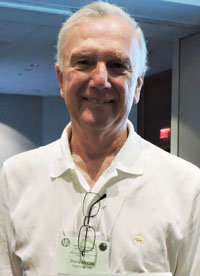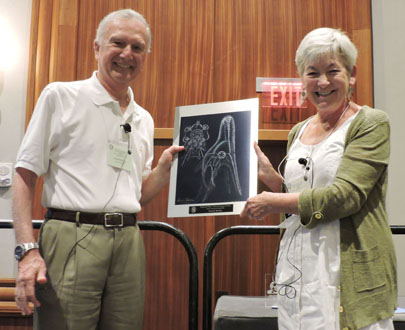David R. McClay Awarded 2016
Developmental Biology-Society for
Developmental Biology Lifetime Achievement Award
By Marsha E. Lucas
 David
R. McClay, Jr., the Arthur S. Pearse Professor
of Biology at Duke University, received the 2016
Developmental Biology-Society for
Developmental Biology Lifetime Achievement Award
for his outstanding and sustained research and
mentoring contributions to the field of
developmental biology. McClay is being recognized
for his distinguished body of work uncovering the
mechanisms underlying cell fate specification,
patterning, and morphogenesis in the sea urchin
embryo. His discovery that nuclear β-catenin
specifies vegetal fates proved to be of great
significance as it is critical for endoderm
specification in numerous vertebrate and
invertebrate species. His group established the role
of Notch signaling in secondary mesenchyme induction
and has been a leader in unpacking sea urchin gene
regulatory networks. David
R. McClay, Jr., the Arthur S. Pearse Professor
of Biology at Duke University, received the 2016
Developmental Biology-Society for
Developmental Biology Lifetime Achievement Award
for his outstanding and sustained research and
mentoring contributions to the field of
developmental biology. McClay is being recognized
for his distinguished body of work uncovering the
mechanisms underlying cell fate specification,
patterning, and morphogenesis in the sea urchin
embryo. His discovery that nuclear β-catenin
specifies vegetal fates proved to be of great
significance as it is critical for endoderm
specification in numerous vertebrate and
invertebrate species. His group established the role
of Notch signaling in secondary mesenchyme induction
and has been a leader in unpacking sea urchin gene
regulatory networks.
McClay earned his Bachelor’s degree in zoology at
Penn State University in 1963 and his Master’s
degree in zoology at the University of Vermont in
1965.
However, it wasn’t until he was a graduate student
at the University of North Carolina, Chapel Hill (UNC),
that he was first introduced to sea urchins. McClay
took an embryology course at the Bermuda Biological
Station (now the
Bermuda Institute of Ocean Sciences) the summer
after his first year of graduate school.
“We collected out in the reef everyday and went
diving and snorkeling for animals,” he said in a
July interview. “I came back from that experience
and decided that Bermuda was a great place to do
research. So, I dreamed up a problem and managed to
do much of my doctoral research in Bermuda.”
McClay studied cell adhesion in sponges under the
mentorship of his graduate advisor, H. Eugene
Lehman. “Gene Lehman at Chapel Hill was wonderful,
and at 96 remains wonderful to my life,” he said.
McClay graduated from UNC in 1971 and headed to the
University of Chicago to do a postdoc with
Aron A. Moscona. There, he began working on cell
adhesion in chick and mouse embryos. Within five
months, McClay had an offer from Duke University to
become a faculty member in the Department of
Zoology. The work he carried out in the mouse and
chick earned him his first grants as an independent
investigator. They were not, however, the only
biological systems on his mind.
“When I got to Duke, I decided that at least a small
part of my research would be looking at the sea
urchin embryo because it’s so simple and perfect for
an experimental embryologist like me,” McClay said.
Sea urchin embryos are transparent, develop rapidly,
and are easy to manipulate, he said. “You can ask a
lot of questions. And because their rate of
development is so fast, you can get answers fairly
quickly.”
What started out as a summer project took over his
entire lab and in 1980, McClay was awarded his first
NIH grant to study sea urchin development. Some
thirty-six years later, he still has that sea urchin
grant.
McClay has been described as “THE world’s expert in
manipulation of living sea urchin embryos.” He says
this came about primarily as a defense mechanism. At
Duke, he was teaching, running a lab, serving on
study sections, and taking on more administrative
responsibilities.
“Life is full of choices and my choice was I did not
want to vacate the laboratory. I decided to look
around and try to figure out what I could do that
would be useful to the laboratory that no one else
in the lab was really interested in doing. I took on
the objective of doing microsurgery and I’ve just
gradually become better and better at it. ... I’m in
there [almost] everyday ... and it allows me to
collaborate on every project with students.”
McClay has trained nearly 6o graduate students and
postdocs in his long career. When asked about his
mentoring philosophy, he said, “There’s no single
formula for doing it. But, I try to work with
students in such a way that allows them to identify
their strengths—and go with them. I don’t know how
good I am, but my students have been pretty darn
successful. So, I’m proud of them all.”
Since his days as a graduate student, McClay has
rarely been home during the summer. He continued to
go to Bermuda up until the mid-1980’s when it became
more important to have time with his children. The
Marine Biological Laboratory in Woods Hole offered a
much more family-friendly opportunity. In 1989, he
became an instructor in the MBL Embryology course
and co-director of the course with Eric Davidson and
Michael Levine from 1991-1996.
McClay now spends his summers in the South of France
at the
Villefranche-sur-mer Developmental Biology
Laboratory located within the Marine Observatory
at Villefranche-sur-mer.
“They’ve been very gracious in allowing me a little
bit of space to set up and do my work,” he said.
|
 |
|
McClay receiving Lifetime Achievement
Award from SDB President-elect, Blanche
Capel at the 75th SDB Annual Meeting in
Boston, MA. |
Interestingly, the work he is doing in France is
based on work first discovered by
Theodor
Boveri (co-discover of the chromosomal theory of
heredity along with
Walter
Sutton). Boveri, while visiting Villefranche in
1901, discovered that the
Paracentrotus sea urchin egg has a
pigment band that surrounds it below the equator
separating the animal and vegetal poles of the egg.
McClay wants to understand how those initial
asymmetries in the egg are established.
“For a long time, we were building gene regulatory
networks along with Eric Davidson’s lab and other
members of the sea urchin community. And, for me,
the whole rationale behind that was to allow us to
identify transcription factors that drive specific
processes in development. And that’s mostly what I
do, to look at what drives gastrulation, what drives
different cell movements. But, I was always puzzled
because... the gene regulatory network we were
working with started at the 16-cell stage. But, you
know there’s something there earlier.”
It is now known that “the vegetal area of the egg
harbors factors that are necessary for specification
of endomesoderm and the animal pole region harbors
factors that are necessary for part of neurogenesis,”
he said.
McClay has learned that you can chop off portions of
the egg, and as long as it has a nucleus, it will
develop. If he cuts off the egg below the pigment
band, cells will divide and divide, but won’t make
endomesoderm. As a result, he now has an assay where
he can add specific maternal factors back to try to
rescue endomesoderm.
“So it turns out,” he said, “if you add back members
of the Wnt pathway, you can rescue endomesoderm. If
you add back, one of the Wnts, you can rescue
endoderm.” He has done this experiment with the
animal pole as well and been able to rescue neurons
by adding back certain not-yet-published maternal
components.
When asked about his most significant discovery to
date, McClay said it is the discovery he’s going to
make tomorrow. “The size of [the discovery] isn’t so
important, it’s just finding something new.”
His scientific journey has not been a solo endeavor.
He expressed his gratitude for several individuals
in his life.
“I very much appreciated
Eric Davidson because he not only was brilliant
and stimulating, but he was a provocateur. I mean,
he would provoke you—make you angry. But, you would
constantly try to say, ‘I’ll show that guy.’ So,
while he was a good friend, he was also a great
provocateur. Eric was important. Another person that
was really important was
John Trinkaus at Yale who when I was younger,
was really terrific in encouraging me and applauding
the efforts that I was putting into looking at
morphogenesis, which is what I’ve been interested in
all my life.”
McClay is a Fellow of the American Academy of Arts
and Sciences. He served as SDB President from
1992-1993 and SDB Treasurer from 2003-2004. He
continues to serve as an instructor for the MBL
Embryology Course, as well as director for the MBL
Gene Regulatory Networks Course. He reflected on
being awarded the DB-SDB Lifetime Achievement
Award.
“It’s an award that really is earned by the students
of somebody who’s been in the business as long as I
have because they are the ones who over the years
have produced most of the work. And so, I tell
people that, and yet they say, oh come on, you’re
just deflecting. But, I’m not. It’s true.”
“...Getting an award like this means that you
haven’t done everything in a complete vacuum. And
that’s nice. I’d like to think that what I’ve done
has been relevant and useful in advancing knowledge.
And to get an award like this means that some other
people are in agreement and that to me means a lot.”
|